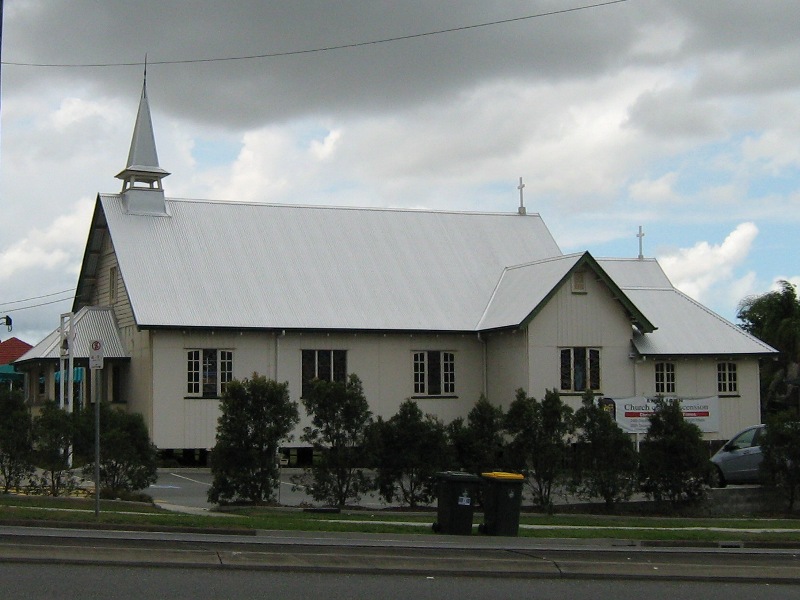Addresses
Type of place
Church
Period
Interwar 1919-1939
Style
Carpenter Gothic
Addresses
Type of place
Church
Period
Interwar 1919-1939
Style
Carpenter Gothic
The Anglican Church of the Ascension, Morningside was built during a period of rapid development in the area. Replacing a smaller timber church, it was dedicated as a memorial to those who had fallen during World War One. Designed by architects Atkinson and Conrad and a landmark on Wynnum Road, it has served the Anglican Parish of Morningside since early last century.
Lot plan
L291_RP12846; L292_RP12846
Key dates
Local Heritage Place Since —
Date of Citation —
Construction
Roof: Corrugated iron;Walls: Timber
People/associations
Atkinson and Conrad (Architect)Criterion for listing
(A) Historical; (E) Aesthetic; (G) Social; (H) Historical associationInteractive mapping
Lot plan
L291_RP12846; L292_RP12846
Key dates
Local Heritage Place Since —
Date of Citation —
Construction
Roof: Corrugated iron;Walls: Timber
People/associations
Atkinson and Conrad (Architect)Criterion for listing
(A) Historical; (E) Aesthetic; (G) Social; (H) Historical associationInteractive mapping
History
Non-Indigenous settlement of the district of Bulimba and its surrounds pre-dates the separation of the colony of Queensland from New South Wales. It was first established as a farming district close to the township of Brisbane and the reliable water of Bulimba Creek. By the end of the nineteenth century the area's location close to the main thoroughfare to Cleveland and, from 1889, the rail line, contributed to its development. Morningside was developed as the Morningside estate on the land owned by David Longland bounded by Wynnum, Thynne, Lytton and Junction Roads. It was originally subdivided into acre-blocks and several dairy farms were established.
Church of England worship at Bulimba was established in 1888 at St John the Baptist church in Oxford Street and as the district grew, Balmoral Parish was established under Reverend J. H. Steer. In 1910 the allotment on which this church stands, subdivisions 290, 291 and 292, was transferred by Gilbert Lang to trustees Arthur Chater, Alvin Rossiter and Thomas Robinson. A timber Church of England was built on the land close to the homes of Ernest Taylor, Builder and Robert Rossiter in about 1911-12. In 1916 title to the land was transferred to the Corporation of the Synod of the Diocese of Brisbane. This small timber church served the local Church of England community until 1924 when the committee in charge of the building fund had accumulated sufficient funds from their annual fetes to build an appropriate church for the growing congregation.
Along with most of local authority areas surrounding Brisbane after the first World War, Bulimba, Norman Park and Morningside experienced rapid population growth. At the stump-capping ceremony for the new church on 10 August 1924, Coadjudicator of Brisbane, Bishop Le Fanu noted that “of late the district had grown to such an extent that it was now necessary to have a real church used solely for divine worship”. He congratulated the parish on their decision “to build a church of wood instead of brick. With limited funds at their disposal, and the uncertainty of the growth of the population of the district, the preference of a wooden church to an unbeautifiul one was, he thought, a very wise one.” As the population of the parish of Morningside would continue to grow, “the church would have to be enlarged in accordance”. Laying the foundation stone he dedicated the church “as a parish memorial of the Brisbane River Centenary, and as a tribute to those who fell in the Great War”.
The church, by architects Atkinson and Conrad, who designed most Anglican churches of the first half of the twentieth century was estimated to cost £1200, of which £400 had been raised. On 25 January 1925, the Archbishop of Brisbane, Dr Sharp, concluded that the people of Morningside had entered “a very important epoch” … by building “this handsome, commodious church”. The new Church of England War Memorial Church, he said “constitutes an artistic architectural adornment to the rising township of Morningside”.
The old 1911 church which had been retained on site was used as a church hall until it burnt down in 2002.
Statement of significance
Relevant assessment criteria
This is a place of local heritage significance and meets one or more of the local heritage criteria under the Heritage planning scheme policy of the Brisbane City Plan 2014. It is significant because:
References
-
Daily Mail 11 August 1924, p.10
-
Daily Mail 26 January 1925, p. 9
-
Brisbane Courier 26 January 1925, p.9
-
Brisbane Courier 11 August 1924, p.8
-
Bulimba Electorate Centenary Committee, History of the Bulimba Electorate 1859-1959, 1959
Citation prepared by — Brisbane City Council (page revised June 2022)

